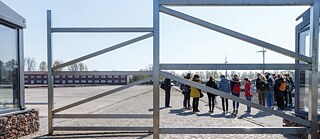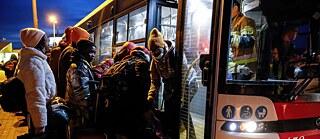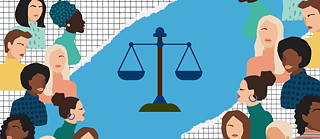Culture of remembrance “We Can All Identify With the Fate of an Actual Individual”

Youngsters are often reproached for lacking interest in history. But studies show that they’re quite interested in the history of National Socialism, for example, though their knowledge of this dark chapter in Germany’s recent past is often sketchy. Ulrike Jensen is the head of Youth Education at the Neuengamme Concentration Camp Memorial in Hamburg. In this interview, she talks about changes over the past few decades and how history can be imparted in a way that speaks to young people.
Ulrike Jensen, you give guided group tours of the Neuengamme Concentration Camp Memorial for school kids. What have been your observations during those tours?
The 15- and 16-year-olds often have misconceptions. Many of them have a smattering of knowledge about the subject, but not the overall picture. Hitler is often seen as the embodiment of evil, as the only one to blame for everything that happened. So we set the record straight: that’s not quite the way it was. Plenty of people voted for him, he had helpers. The kids often say they were taught that the SS men (the infamously brutal Schutzstaffel that was responsible for most of the genocide during the Holocaust and ran the concentration camps – Editor’s note) didn’t do so voluntarily. Not true: we know that none of the concentration camp overseers from the SS was there against his will. Then we point out that each of them had some personal leeway: even if I am forced to work in a camp, that doesn’t mean I have to add gratuitous cruelty.
These are really harrowing subjects. How do you talk about this sort of thing to teenagers?
First we field any questions they may have. Then we take a biographical approach. We can all identify with the fate of an individual person, each of us can personally relate to it. My maxim is: Don’t overwhelm them, but don’t pass over in silence what actually happened either. Many memorials used to show a documentary about the liberation of Bergen-Belsen concentration camp (based on British army footage from 1945 – Editor’s note). But they stopped showing the film several years ago. The story of a single person draws the viewer in more closely than details of mass atrocities. People tend to tune out. So we leave room for them to develop their own feelings about what happened here.
How do you go about that?
We explain and provide background: What did the SS do and why. After all, nothing was left to chance in the running of a concentration camp: they knew exactly what they were doing and why. Sometimes you have to take it to the meta-level. Social phenomena like exclusion, for example, can be used to explain how concentration camps worked. The SS applied the strategy of “divide and rule”, which always works.
What does “divide and rule” mean?
I divide a group into several little subgroups and treat them differently. What happens then? Dissension. Kids get the point right away – it calls to mind familiar classroom situations: The teacher’s pet, who gets preferential treatment, will eventually be ostracized by the class, even if he’s actually a nice fellow. Envy undermines class cohesion. Here in the camp every little thing was a matter of life and death. Each bread crust you got – or didn’t get – counted. This also helps young people grasp why there were hardly ever any revolts in the concentration camps.

Schoolgirls on a tour of Neuengamme Concentration Camp looking at a historical Reichsbahn freight wagon, once packed with load after load of new arrivals, which serves as a symbolic stand-in for the former railway station at the camp. | Photo (detail): © picture alliance/dpa/Markus Scholz
You’ve been working in this field for nearly forty years now. What has changed over that time?
All in all, not much. Though in the 1990s, young people could still meet Holocaust survivors in person. Even the schoolyard bullies will pipe down when an old man standing right in front of them tells them what he went through here. They suddenly grasp that these are real stories of what happened to real people. There are hardly any Holocaust survivors left today. We do show excerpts from interviews, but the direct contact is missing. Nonetheless, young people are still interested.
What approach do you recommend for schools?
I think the best approach is to tell the stories of real individual people. But context is key too. If you’re talking about the 1948 Universal Declaration of Human Rights, for instance, then you naturally have to put across that it was a logical consequence of World War II: one thing leads to another, action and reaction. Whatever epoch they’re teaching, teachers shouldn’t present historical events as isolated phenomena sealed off from others: they should help students connect the dots and draw parallels to other events and epochs.
How can we make public history more accessible to young people?
We’ve been running participatory projects for years. When we’re planning a new memorial, for example, we tell young people a bit about the history of the site and ask them: How do you want to remember this? What should such a place be like so it will actually speak to you? Participation is the name of the game. This doesn’t mean everything has to be carried out the way they propose, but it’s a good idea to listen to their suggestions and take them into consideration. Which makes them feel they’re being taken seriously. That’s the best thing you can do. In the classroom, too.


